March 13, 2024

Turkish troops blocked one-way of bridge in Istanbul on July 15 as people protested during the July 15, 2016 failed coup attempt. (Photo by GURCAN OZTURK / AFP)
Abdullah Bozkurt/Stockholm
The second largest army in the NATO military alliance in terms of manpower was slated for transformation into a caliphate army under the command of Islamist President Recep Tayyip Erdogan, according to a long-time confidant of the president who was involved in influence operations both within Turkey and abroad.
“A true Anatolian, caliphate army will be established, and the disgrace of taking orders from the United States will come to an end for the Turkish Armed Forces [TSK],” Erol Olçok, a close advisor who had been closely working with Erdogan since the 1990s, wrote on social media platform X, previously Twitter.
He further added that the army would receive orders directly from the Reis (Chief Erdogan), who would soon be directing military operations as head of the army. Olçok described these changes as a dream that would soon become a reality.
“An army befitting the leader of the Islamic world and this land will be established. Let all the rats within the TSK tremble; a major [crackdown] operation is on the horizon. Very soon, we will see chiefs of general staff leading prayers for their army. … This summer, during the Feast of the Sacrifice, all infiltrators within the TSK will be purged, and this land will be cleansed. Let it be known that the commander-in-chief, the leader, will ensure this,” Olçok wrote.
Olçok’s tweet came five days before a failed coup on July 15, 2016, which, as he predicted, resulted in a significant purge within the military. Two-thirds of all generals and admirals as well as nearly all staff officers were abruptly dismissed. A total of 23,971 personnel, primarily in the officer ranks, were purged from the Turkish army without any military, administrative, or criminal investigations.
The purge primarily targeted pro-NATO officers or individuals who had served in NATO assignments, at NATO headquarters in Brussels or NATO-affiliated bases in the US, Norway, Germany, Italy and Spain. Evidence presented in coup trials revealed that the profiling of those to be purged was quietly carried out between 2014 and 2016 by Turkish intelligence agency MIT and its extensive network of informants.
The Erdogan government required a pretext to initiate the widespread purge, not only within the military but also across all state institutions, including the police, intelligence agencies, judiciary and foreign service. This pretext would justify the declaration of emergency rule, enabling the shutdown of hundreds of media outlets and the imprisonment of tens of thousands of people on fabricated charges. MIT orchestrated the failed coup attempt, providing the necessary pretext for these actions.
Olçok wasn’t just an ordinary advisor to Erdogan; their association dated back to the 1990s, when the president served as the mayor of Istanbul. Over the years Olçok had evolved into a confidant and trusted figure within Erdogan’s inner circle. His significance stemmed from successfully managing 11 election campaigns, both local and national, for his boss within a decade.
Having worked closely with Turkish intelligence, Olçok also spearheaded influence operations in foreign countries to support Erdogan’s associates and enhance his standing among Muslims globally. He played a pivotal role in promoting the late Egyptian president Mohamed Morsi during his election campaign in 2011, effectively managing his campaign from behind closed doors. Olçok and then-Turkish intelligence chief Hakan Fidan were in Egypt attempting to salvage Morsi’s presidency amid massive protests and the army’s threat to oust him in the summer of 2013.
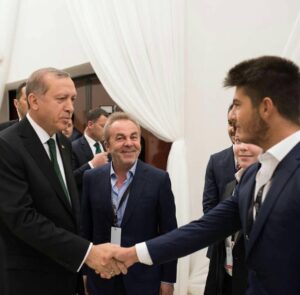 Turkish President Erdogan (L) shakes hands with Abdullah Tayyip Olçok, the son of Erol Olçok (C).
Turkish President Erdogan (L) shakes hands with Abdullah Tayyip Olçok, the son of Erol Olçok (C).Olçok was also one of the key architects of the crackdown on independent and critical media outlets in Turkey. In 2015 he and his associates filed criminal complaints against around a dozen media outlets, including Zaman, the most widely circulated newspaper in Turkey. Subsequently, all the media outlets targeted by Olçok were either taken over by the government or shut down in 2016.
The series of tweets he wrote five days before the July 15 events proved prophetic, as Erdogan not only restructured the Turkish military into a protective force to safeguard his regime through the massive purge but also filled the vacated ranks with many Islamists.
The pro-Erdogan paramilitary group SADAT (Sadat Uluslararası Savunma Danışmanlık İnşaat Sanayi ve Ticaret Anonim Şirketi), which advocates for a united Islamic army, played a significant role in the restructuring of the Turkish military. Established as a for-profit company by former colonel Adnan Tanrıverdi on February 22, 2012, SADAT has taken part in training and arming jihadists in Syria and Libya.
In the aftermath of the failed coup, individuals associated with SADAT were involved in conducting interviews for cadets, assessing candidates for acceptance into the Turkish army and influencing decisions regarding promotions within the ranks.
Tanrıverdi, who regards Erdogan as the long-awaited Mahdi, the prophesied redeemer of Islam for whom the entire Muslim world is waiting, assumed the role of chief military advisor to Erdogan following the failed coup in 2016. While he officially left his position in January 2020, he continues to wield significant influence over the government’s defense and military strategy.
 Adnan Tanriverdi
Adnan TanriverdiAs predicted by Olçok, Erdogan began appearing in military fatigues for the first time since 2016, and he was seen at military operation headquarters, accompanied by high-ranking generals and the chief of general staff, directing Turkish army operations in Syria. These operations involved support from opposition rebel Islamist groups aiding the Turkish military.
Once again, as predicted by Olçok, the disengagement from the US was underway in 2016. Public prosecutors, acting on orders from the government, initiated investigations into US military officers deployed at Turkey’s Incirlik Airbase, home to the US Air Force’s 39th Air Base Wing. Senior US Defense officials and commanders who visited the base were the subjects of sham criminal investigations.
A year after the core of the army’s officer corps was hollowed out, Turkey and Russia signed a contract on April 11, 2017 for two S-400 systems valued at around $2.5 billion. The initial delivery of S-400 missile batteries, which commenced on July 12, 2019 and concluded in September 2019, comprised two S-400 batteries and over 120 long-range missiles, along with experts tasked with training Turkish soldiers on their operation as part of the agreement.
Olçok’s tweets were cited in dozens of testimonies by multiple defendants in various courts during the coup trials, but not a single court issued a ruling to investigate the messages to find out how Olçok knew what would happen:
Testimony of defendant İlyas Yasar on Erol Olçok’s tweets at the Mugla 2nd High Criminal Court:
Despite warnings from the US, President Erdogan proceeded with the purchase at a significant cost. Ankara not only faced expulsion from the global F-35 Joint Strike Fighter program but also incurred a series of sanctions, embargoes and restrictions on the procurement of defense items from the US and other NATO allies.
Olçok’s revelations were made from the @foto_siyaset Twitter account, under the handle Fotoğraf ve Siyaset, which was believed to have been managed by Olçok and his team. The account boasted 81,000 followers, including many influential figures from President Erdogan’s inner circle, such as the current chief of Turkish intelligence, İbrahim Kalın, Justice Minister Yılmaz Tunç and the president’s chief economic advisor, Yiğit Bulut.
The messages were deleted a few days later, and the account, established in July 2012, underwent cleaning and restructuring. However, the internet archive Wayback Machine captured a snapshot of the account on July 19, 2016, displaying the original messages posted on July 10. The pinned tweet at the top of the messages stated that the account was frozen to prevent any harm from coming to President Erdogan.
Despite the deletion of the original tweets and the reconstruction of the @foto_siyaset account in an attempt to mitigate the situation, Olçok’s messages were shared by some troll accounts associated with the Justice and Development Party (AKP) government for propaganda purposes. Some of these accounts, such as eski_İstanbulum, still remain accessible today and reposted Olçok’s messages verbatim on July 10, 2016.
 Turkish military controls a road in Istanbul on July 16, 2016. (Photo by GURCAN OZTURK / AFP)
Turkish military controls a road in Istanbul on July 16, 2016. (Photo by GURCAN OZTURK / AFP)The Twitter account @foto_siyaset is still active today, but it has undergone significant changes since its original incarnation. The entire history of posted messages has been deleted, indicating a fresh start for the account. It appears that a new user has taken over the account, possibly after it remained dormant for some time.
The early revelations that exposed the false flag coup seem to have sealed Olçok’s fate, as he and his son Abdullah Tayyip Olçok were executed on the street on July 15 in what appears to be a sniper shooting. Although the murders were attributed to alleged putschists, ballistic reports revealed that they were killed by a gun not used by the military. What is more, the direction of the bullets indicated that they came from the back, rather than the front where the alleged putschists were stationed.
Turkish authorities did not investigate Olçok’s messages despite multiple motions by defendants in the coup trials. Furthermore, the deaths of Olçok and his son were not effectively investigated. During one court hearing a witness testified that an unidentified gunman from a black Volkswagen transporter van fired at the crowd, which included Olçok and his son. Turkish intelligence agency MIT often employs black transporter vehicles in its clandestine operations. Another claim suggested that MIT may have assigned a sniper to carry out the hit on him. However, none of these claims were properly investigated by authorities.
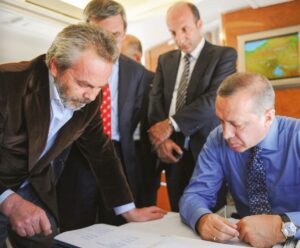 Erol Olçok had worked for Turkish President Recep Tayyip Erdogan for decades.
Erol Olçok had worked for Turkish President Recep Tayyip Erdogan for decades.It was also reported that Olçok was directed to go to the Bosporus Bridge over the phone by a Turkish intelligence agent whom he trusted and did not suspect. It seems he was lured to the scene for the execution. There were rumors suggesting that Turkish intelligence chief Hakan Fidan, currently the foreign minister, got the hit approved by Erdogan, who went along with the murder after Olçok’s exposé on Twitter regarding the false flag plan.
The autopsy reports for both Olçok and his son strongly suggested foul play, with evidence pointing more towards a sniper shooting. Olçok’s autopsy report showed that a bullet passed from the upper lobe of the left lung to the lower lobe of the right lung, resulting in Olçok’s death. In other words, the bullet entered from the left shoulder and exited from the lower right back. This trajectory indicates the front-to-back and top-to-bottom movement of the bullet, consistent with a sniper shooting.
Considering the bullet trajectory, it appears highly unlikely that Olçok was killed by a bullet allegedly fired by soldiers on the Bosporus Bridge, where troops were deployed on the pretext of responding to a terrorist threat, not a coup. This is because both the troops and Olçok were on the same road. If he was indeed killed by a bullet fired by a soldier, the entry and exit points would likely be on the same level. The trajectory of the bullet lends credence to the claims that he was actually killed by sniper fire from a gunman rather than by soldiers.
The autopsy report for Olçok’s son indicated the presence of a 7.62 mm caliber bullet core in the soft tissue, suggesting it as the cause of death. It’s important to note that the standard military rifle in the Turkish army is the G3 infantry rifle, which is manufactured in Turkey under German license by the Mechanical and Chemical Industry Corporation (MKEK). It is a a powerful weapon capable of firing bullets over long distances, up to nearly 4,000 meters, with an effective firing range of 400 to 500 meters.
Court records from May 2019 that provide details on the autopsy reports for Erol Olçok and his son:
Zoom 100%
Given that the distance between the civilians gathered on the Bosporus Bridge and the soldiers was only 100 to 200 meters, it seems implausible for the bullet to have become lodged in Olçok’s son’s body at such a short range. It should have gone straight through the body, not remained inside. At this range, the bullet could easily penetrate significant obstacles, such as a pine tree with a diameter of 90cm. This further supports the hypothesis that Olçok’s son was likely shot by a different weapon or from a different location.
However, Turkish authorities did not conduct ballistic tests on the G3 rifles seized from the soldiers, nor did they perform a forensic examination of the bullet core allegedly extracted from the body. It is evident that the murders were not thoroughly investigated and were quickly hushed up. This lack of a comprehensive investigation raises serious questions about the true circumstances surrounding the deaths of Olçok and his son.
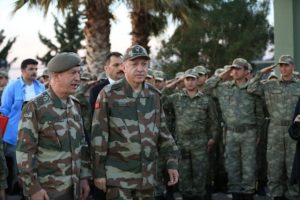 Turkish President Recep Tayyip Erdoğan
Turkish President Recep Tayyip ErdoğanIt is indeed perplexing that the Erdogan government did not push for a full-scale investigation, especially considering Olçok’s close ties to the president. This raises suspicions about the government’s involvement or lack of willingness to uncover the truth behind Olçok’s death and its potential implications.
Nihal Süleymanoğlu, Olçok’s ex-wife, has raised questions about the circumstances surrounding the murder of her son and ex-husband, but she herself became a target of a witch-hunt. Despite being expected to have custody of her two surviving children after her ex-husband’s death, a Turkish court awarded custody to Erol’s brother, Cevat Olçok, instead of the mother in August 2016. This decision has sparked further concerns and raised questions about the handling of the case by the authorities.
Süleymanoğlu has dual nationality, having been born in Skopje, North Macedonia, before relocating to Turkey. She was among the founders of the opposition Future Party (Gelecek Partisi), an Islamist party led by former prime minister Ahmet Davutoğlu. However, she resigned from the party in November 2023, indicating that she might consider joining Erdogan’s ruling AKP if her lingering questions about the events of July 15 were clarified.
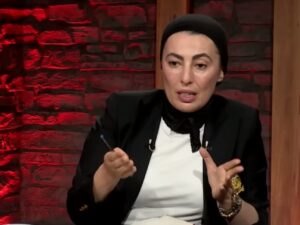 Nihal Süleymanoğlu, Erol Olçok’s former wife.
Nihal Süleymanoğlu, Erol Olçok’s former wife.Questions regarding Olçok’s tweets were raised during a debate in the parliamentary commission established to investigate the coup. When testifying before the commission, Galip Mendi, former commander of the gendarmerie, denied having any knowledge of Olçok’s revelations when asked whether gendarmerie intelligence had picked up on the chatter and investigated Olçok’s messages before July 15. However, the commission’s final report mysteriously disappeared from the parliamentary records, further fueling suspicions of a cover-up.
Educated at a an imam hatip religious high school like his boss Erdogan, Olçok set up several advertising and public relations firms after graduating from Istanbul University’s art history department. He gained prominence by successfully running Erdogan’s mayoral election campaign in 1994 and later became his press advisor when Erdogan assumed office as the mayor of Istanbul. After that, Olçok played a crucial role in promoting and establishing the AKP, responsible for promoting the party and designing its logo. He was one of the original founders of the AKP.
Some have drawn comparisons between Olçok and Paul Joseph Goebbels, the chief propagandist for Adolf Hitler’s Nazi Party in Germany during the 1930s and ’40s. Ethnically a Circassian, Olçok had also worked closely with the Circassian diaspora in Turkey.
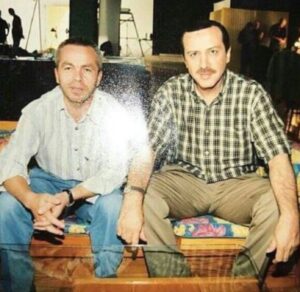 Erol Olçok started working with Turkish President Recep Tayyip Erdogan in the 1990s.
Erol Olçok started working with Turkish President Recep Tayyip Erdogan in the 1990s.
Δεν υπάρχουν σχόλια:
Δημοσίευση σχολίου